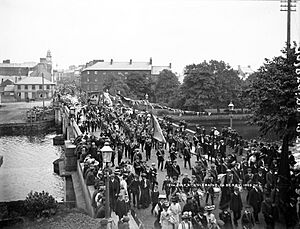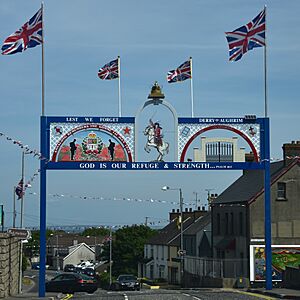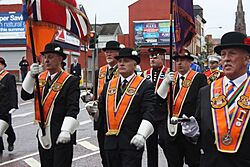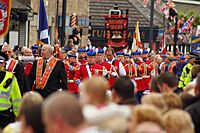The Twelfth facts for kids
Quick facts for kids The Twelfth |
|
|---|---|
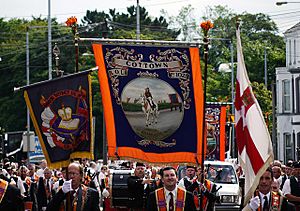
Orangemen parading in Bangor, 12 July 2010
|
|
| Also called | Orangemen's Day |
| Observed by | Orange Order, Ulster Protestants, Ulster-Scots people |
| Significance | Celebration of the Glorious Revolution (1688) and victory of William of Orange at the Battle of the Boyne (1690) |
| Celebrations | Parading, bonfires, erecting flags and bunting |
| Date | 12 July |
| Frequency | Annual |
| Related to | The Eleventh Night |
The Twelfth, also known as Orangemen's Day, is a yearly celebration for Ulster Protestants on July 12th. It marks the victory of the Protestant king William of Orange over the Catholic king James II at the Battle of the Boyne in 1690. This victory was a key moment in the Glorious Revolution.
On and around the Twelfth, the Orange Order and marching bands hold large parades. Streets are decorated with Union Jack flags and colorful decorations called bunting. On the night before, known as the Eleventh Night, huge bonfires are lit.
The Twelfth is mainly celebrated in Northern Ireland, where it is a public holiday. Smaller celebrations also happen in other places like Scotland, Canada, and Australia.
Many Ulster Protestants see the Twelfth as a big part of their culture. However, some Irish nationalists and Catholics view it as a celebration that is against their beliefs. In the past, the parades sometimes led to tensions between the two communities. Today, most events are peaceful, and there are efforts to make them more welcoming to tourists and families.
If July 12th is a Sunday, the parades take place on Monday, July 13th.
Contents
The Story Behind the Celebration
The celebrations of the Twelfth began in the late 1700s. At first, Protestants in Ulster celebrated different events from the 1600s. One was the birthday of King William of Orange on November 4th. Another was the Battle of Aughrim, a major victory for William's army, which happened on July 12th, 1691.
The Battle of the Boyne was fought on July 1st, 1690. So why is it celebrated on July 12th? It's because Britain switched from the Julian calendar to the Gregorian calendar in 1752. This change moved the date of the Battle of the Boyne forward by 11 days.
When the Orange Order was formed in 1795, they chose to focus on the Battle of the Boyne. This was because King William himself fought in that battle. The first Orange Order parades were held on July 12th, 1796. In the early 1800s, the parades sometimes caused trouble and were even banned for a while.
How The Twelfth is Celebrated
Getting Ready for the Big Day
In the weeks before July 12th, many Protestant areas in Northern Ireland are decorated. People hang up flags, like the Union Jack and the Ulster Banner, and colorful bunting. Sometimes, they paint sidewalk curbs red, white, and blue.
Large arches, called 'Orange arches', are built over some streets. These are decorated with flags and symbols related to the Orange Order. In some areas, flags of loyalist groups are also flown, which can sometimes cause tension with nearby Catholic or nationalist communities.
The Bonfires of Eleventh Night

The night before the Twelfth is called "Eleventh Night". In many Protestant neighborhoods, huge bonfires are lit. These are often built by local young people using wooden pallets. The lighting of the bonfires is usually a big event with street parties and music from marching bands.
These bonfires can be controversial. Sometimes, things like Irish flags are burned, which is seen as disrespectful by many. There have been efforts to make the bonfires safer and more focused on community celebration rather than politics.
The Main Parades
The main event of the Twelfth is the large parades. Members of the Orange Order, called Orangemen, march with bands through towns and cities. The parade route often ends at a large field or park.
At the park, people gather for speeches, food, and music. There is often a church service as well. The parades are a colorful sight. Marching bands play music on instruments like the Lambeg drum, which is a very large and loud drum mostly used in these parades.
Most marchers are men, who often wear a dark suit, an orange sash, white gloves, and a bowler hat. There are also lodges for women, and some bands have female members. Both men and women carry large, beautifully decorated banners. These banners often show pictures of King William of Orange or other historical scenes.
Celebrations Around the World
Britain
The Twelfth is also celebrated in Scotland, especially in Glasgow, where many people have family roots in Ulster. In England and Wales, the parades are smaller and often held a week before July 12th. This allows bands and lodges to travel to Northern Ireland for the main events.
Canada
The Twelfth has been celebrated in Canada since 1821. For a long time, the parade in Toronto was one of the largest in North America. Today, the parades are much smaller. In the province of Newfoundland and Labrador, Orangemen's Day is still a paid holiday for government workers.
Australia
Orange lodges in Australia have seen a revival in recent years. An annual Twelfth of July parade is now held in the city of Adelaide.
Republic of Ireland
Before Ireland was divided in the 1920s, the Twelfth was celebrated in many parts of the country. Today, the only major parade in the Republic of Ireland is at Rossnowlagh in County Donegal. It is held on the weekend before July 12th.
See also
 In Spanish: Día de los Orangemen para niños
In Spanish: Día de los Orangemen para niños
- Culture of Northern Ireland
- Culture of Ireland
- Orange walk


